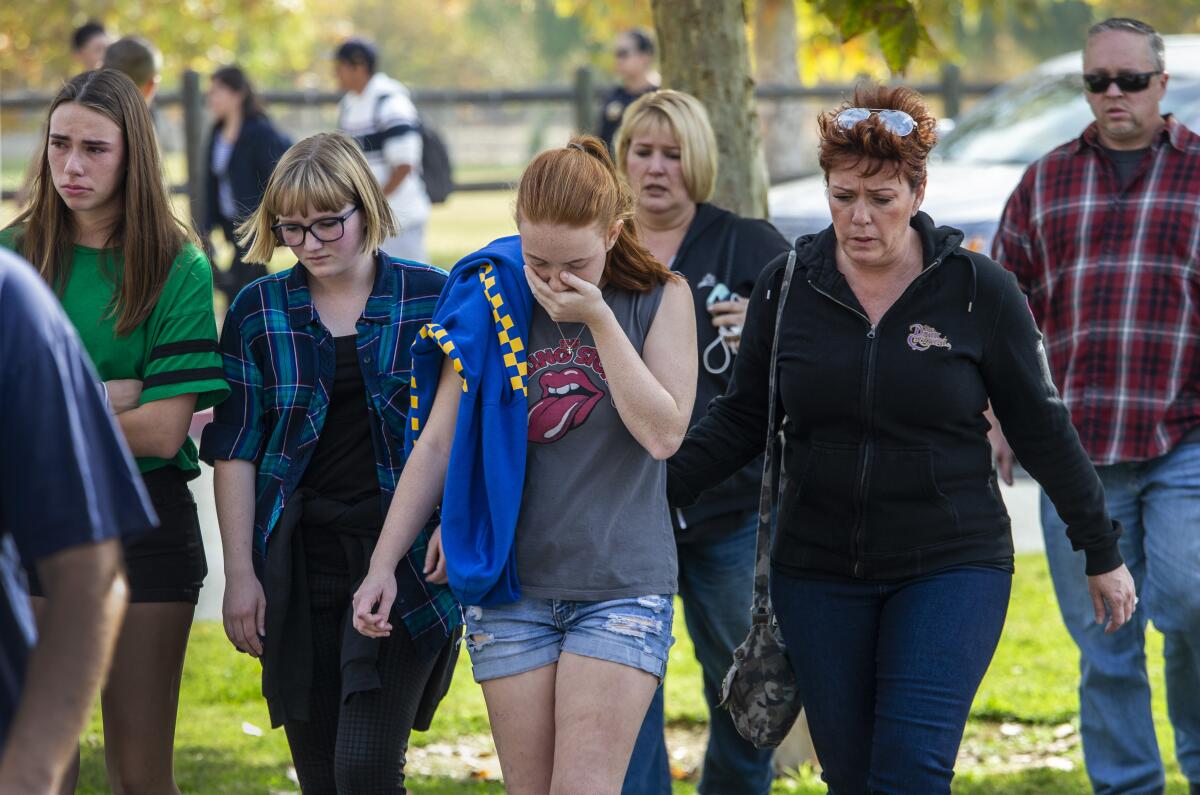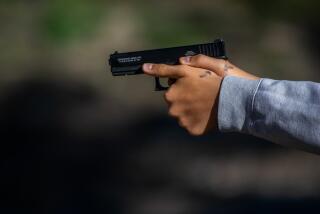Opinion: There is no single profile of a mass shooter. Our data show there are five types

- Share via
On Thursday morning in Santa Clarita, basic details about America’s latest mass shooting emerged quickly: Two victims, a teenage girl and boy, were dead; three others were wounded; and a 16-year-old male suspect, a student at Saugus High School, was in custody in grave condition, with a self-inflicted gunshot wound to the head.
Andrei Mojica, who’d been in his AP government class when the shooting started, described a now familiar drill — building a barricade with desks and chairs against the classroom door, grabbing a fire extinguisher for protection and hunkering down, straining to hear what was going on.
“The fear made it seem like we were waiting in silence forever,” Andrei told The Times.
With every mass shooting, myths compete with facts as investigators do their painstaking work. The day after the killings at Saugus High School, authorities were still searching for a motive, but much of what they did know about the 16-year-old suspect, Nathaniel Berhow, fit with remarkable fidelity the profile that we’ve found defines K-12 shooters.
As part of a project funded by the U.S. Department of Justice, we’ve studied all of the 171 mass shootings in public spaces that killed four or more people between 1966 and 2019. Separately, we also looked at episodes in which active shooters killed one or more people and very nearly killed more.
Who commits these acts? Here’s what we’ve learned.
The vast majority (98%) of mass shooters are men. Fifty-two percent are white and 70% of them know at least some of their victims. In most cases, they don’t use assault weapons (only 25% ), although that figure is rising (to 39% in the last 10 years). Handguns remain the mass shooters’ weapon of choice, as is true of U.S. homicides in general and as was true in Santa Clarita.
And even those facts don’t give a complete picture. In our database, we have coded each of the mass shooters, taking into account more than 100 variables pertaining to their life histories and crimes. The results, which we will publish on Tuesday, make clear that to really understand the profiles of such killers, you have to look at where the crime took place. Attacks in churches are perpetrated by a different type of person than attacks in malls and restaurants. And attacks at schools are carried out by very different types depending on whether they are at colleges or high schools.
- The K-12 school shooter (based on our analysis of 13 mass shooters and 54 attempted mass shooters) is usually a white (85%) male (100%) student or former student of the school (91%) with a history of trauma (70%). Some 92% of K-12 shooters are suicidal. The schools affected tend to be suburban or rural (92%) public (98%) high schools (93%), and the shootings most often occur at the start or end of the school year, in September or May. Some 87% of K-12 shooters leak their plans ahead of time, and 85% show a high degree of planning. The majority of the shooters have a previous interest in guns and, 80% of the time, use multiple guns belonging to family members.
- The college and university shooter (nine mass shooters) is usually a non-white (11% black, 45% Asian, 33% white) male (100%) who is a current student of the university (78%), has a history of violence (89%) and childhood trauma (67%), and is suicidal (100%). Some 89% of college shooters use legally obtained handguns and 78% leave behind messages about their crimes, such as videos or manifestos. These shootings most often occur at large, urban, public universities.
- The workplace shooter (48 mass shooters) is usually a male (96%) in his 40s who is an employee of the shooting site (78%) and having trouble at work. Workplace shooters don’t have a racial profile (40% white, 30% black, 10% Latino). They tend to use handguns (85%) that they legally own (71%). About 90% of these shootings occur at blue-collar job sites, and 83% of the perpetrators have been recently fired or suspended. Some 78% of workplace shooters are suicidal, and 31% have a military background. The communities where workplace shootings occur tend to be largely white with low rates of college education and high rates of unemployment, most often in the South or West.
- The house of worship shooter (11 mass shooters) is usually a white (73%) male (100%) in his 40s who is suicidal (73%). Some 78% of such shootings involve Christian churches, followed by 16% in synagogues or other Jewish meeting places, and nearly 50% of perpetrators know their victims. Every one of the perpetrators used a handgun and 36% also used an assault rifle. These shootings show a low degree of planning and are more targeted, often motivated by family issues (30%) or racial or ethnic hatred (40%). Some 73% of church shooters have prior criminal records and violent histories.
- The retail/restaurant shooter (46 mass shooters) is usually a white (57% white, 17% black) man (100%) of about 30, with no connection to the location. Some 65% use one gun, typically a handgun (67%). One-third show evidence of a thought disorder, 67% have a violent history, 71% have a criminal record, and 22% have a military background. Only 9% of these attacks demonstrate a high degree of planning. We have seen the biggest increase in this category in recent years.
Understanding what kind of person commits these crimes in each of the different settings is only a first step. We also need to use the profiles to better prevent and respond to mass shootings. For example, because school shooters are nearly always students of the school, alterations to building design and conducting active shooter drills are likely to be ineffective, since the shooter is an insider, well-rehearsed in the security procedures. The same goes for workplace shooters, who typically are employees or former employees.
In every category, more than 80% of perpetrators are in crisis prior to the shooting. Investments in school and employment-based mental health services and training in crisis intervention and grievance mitigation could help prevent assaults.
Age restrictions, “red flag” laws, waiting periods and background checks for all firearm sales may especially help prevent college shootings where a large majority of perpetrators are in a known crisis and legally purchase guns, despite histories of psychiatric hospitalization (44%) or criminal records (67%).
Investments in domestic violence programs as well as aggressive monitoring of the internet to deploy countervailing messaging and disrupt online hate groups might help prevent church shootings. Target-hardening and other situational crime prevention measures may be most important for retail establishments, bars and restaurants, where the perpetrator is usually not connected to the site.
Once we understand mass violence, we can devise interventions that will reduce it. But that will take moving beyond party lines over gun control to plan and implement data-driven, evidence-based solutions.
Jillian Peterson is a psychologist and professor of criminology and criminal justice at Hamline University. James Densley is a sociologist and professor of criminal justice at Metropolitan State University. They run the Violence Project.
More to Read
A cure for the common opinion
Get thought-provoking perspectives with our weekly newsletter.
You may occasionally receive promotional content from the Los Angeles Times.










